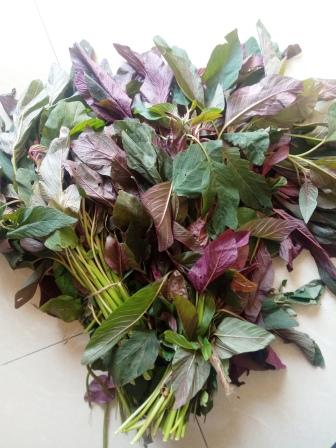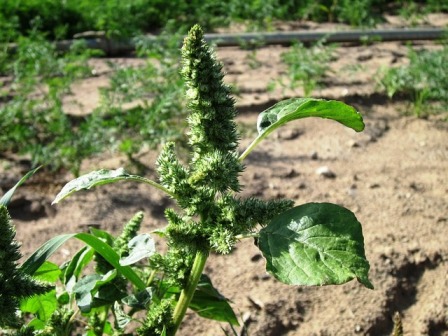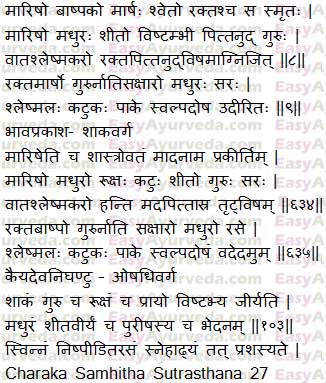Amaranth Uses, Qualities, Remedies, Research

By Dr Renita D’Souza
Amaranth is a multipurpose plant used as grain and leafy vegetable. In Greek, Amaranthus means immortal. Amaranth grain is gluten free and it is a rich source of protein, lipids, calcium, potassium, phosphorus and dietary fibre. In India, Amaranthus grain is commonly called as Rama’s grain (Rajgira)
Read – Pointed Gourd Health Benefits, Usage – Ayurveda Details
Table of Contents
Introduction
There are different species of amaranthus, some are edible and possess medicinal benefits. The extract of Amaranthus is used to treat different diseases like respiratory disorders, gynecological diseases, diabetes, urinary tract infections, diarrhea, inflammation, pain etc. (A)

Amaranth Seed oil – It is obtained from seeds of Amaranthus cruentus and Amaranthus hypochondriacus. It is rich in linoleic acid, oleic acid and palmitic acid. (read)
Medicinal Qualities
Taste – sweet
Slightly heavy to digest
Vipaka (taste conversion after digestion) – Katu (pungent)
Sakshaara – alkaline in nature
Sara – causes bowel movement
Shleshmala – increases kapha dosha
Swalpa dosha udeeritah – slightly increases dosha
Part Used
Roots, Leaves, Stem, Seeds
Traditional Uses
- The roots, stem and leaves are good liver tonic
- Roots and seeds are used to treat white discharge from vagina, impotence, colic, gonorrhea and eczema. They have galactagogue property which is used to promote and increase breast milk.
- Roots are used to relieve pain and inflammation. They act as demulcent. (A)
Traditional Remedies
- Root decoction along with Cucurbita pepo Linn. is used to control bleeding following abortion.
- Root decoction is used to relieve piles and diarrhea in children.
As per the reference found from Charaka Samhita Sutrasthana 27 the chapter, Maarisha is mentioned under Supya shaka (vegetables fit to make soup). All these vegetables have following qualities –
Guru – heavy to digest
Rooksha – dry
Madhura – sweet in taste
Sheeta veerya – cold potency
Bhedana – purgative
They produce wind during the process of digestion.
It is wholesome when consumed by boiling and draining the juice, and adding excess of fat substances.
Read – Watermelon (Citrullus lanatus) – Uses, Remedies, Research, Side Effects
Nutritional Value
Leaves of red amaranth are rich in proteins, iron, calcium, zinc, vitamin C and vitamin A.
Amaranth grain was the staple food of the Aztecs and in some parts of Mexico. The amaranth grain is made into popcorn, or served with honey or milk. It can be mixed with dry fruits and nuts. Amaranth can be cold pressed to get Amaranth oil.
Pharmacological Activity
Amaranthus tricolor possesses antioxidant, hepatoprotective, antiviral nd antiproliferative activity.
Phytochemicals
Amaranthus tricolor contains carbohydrates, flavonoids, proteins and amino acids, steroids and fatty acids (palmitic, linoleic, lignoceric and archidic acid)
Read – Carrot (Gajar): Benefits, Remedies, Research, Side Effects
Maarisha
In Ayurveda, Amaranthus is included under the group of Vegetables (shaka varga). Maarisha in Sanskrit is referred to a plant of Amaranthus species. There are 2 varieties, Swetha maarisha (Amaranthus blitum) and Rakta maarisha (Amaranthus tricolor).
Read – Ridge Gourd: Benefits, Remedies, Research, Side Effects
Sanskrit Synonyms, Varieties
Sanskrit Synonyms
Maarisha, Vashpaka, Marsha
Varieties
Swetha maarisha- white variety
Rakta maarisha – red variety
Swetha Maarisha
Botanical Name – Amaranthus blitum
Synonym – Amaranthus lividus
Family – Amaranthaceae
Related Plant – Amaranthus viridis, commonly called as slender amaranth or green amaranth. It is also used as vegetable.
Vernacular Names
Hindi Name – Marasa
English Name – Purple amaranth, Guernsey pigweed, Livid amaranth
Bengali Name – Saadanate
Gujarati Name – Dhaambho
Kannada Name – Harive soppu
Tamil Name – Tandukirai
Telugu Name – Totakuda
Konkani Name – Bhaji
Marathi Name – Bhaji, Matachi bhaji
French Name – amarante verte
Medicinal Qualities
Taste – sweet
Vipaka (taste conversion after digestion) – pungent
Potency (virya) – cold
Ruksha – dry
Vishtambhi – causes constipation
Pittanuth – balances pitta dosha
Guru – heavy to digest
Effect on Tridosha
Increases vata and kapha dosha
Read – Winter Melon Health Benefits, Medicinal Use, Side Effects
Therapeutic Uses
Raktapitta – used in bleeding disorders
Vishamagnijith – corrects vishamaagni (fire governed by vata)
Mada – intoxication
Trit – excess thirst
Visham – poisoning
Remedies
- The leaves are used to treat fever.
- The poultice prepared from leaves is used to treat inflammation, boils and abscess.
- It is also used as a remedy for lung disorders.
- Tincture prepared with dried seeds and leaves is used to prevent flu and colds.

Interaction with medicines, supplements
Can this be used while taking Homeopathic medicine?
Yes. This product does not react with homeopathic medicine.
Can
this medicine be continued while taking supplements like multivitamin tablets,
Omega 3 fatty acids etc?
Yes. Generally, this product goes well with most
of the dietary supplements. However, if you are taking more than one product
per day, please consult your doctor for an opinion.
With western
medicines
Seek your
doctor’s advice if you are taking this product along with other western
(allopathic / modern) medicines. Some Ayurvedic herbs can interact with modern
medicine.
If both Ayurvedic and allopathic medicines are advised together, then it is
best to take Allopathic medicine first, wait for 30 minutes and then take the
Ayurvedic medicine.
Nutritional Values
Amaranthus leaves contain water 88.9 g, energy 18 kcal, protein 3.5 g, fat 0.3 g, carbohydrate 0.3 g, dietary fiber 2.6 g, Ca 270 mg, Mg 130 mg, P 65 mg, Fe 3.0 mg, carotene 1725 μg, thiamin 0.07 mg, riboflavin 0.22 mg, niacin 0.7 mg, folate 85 μg, ascorbic acid 42 mg. (read more)
Scientific Classification
Kingdom – Plantae
Phylum – Spermatophyta
Subphylum – Angiospermae
Class – Dicotyledonae
Order – Caryophyllales
Family – Amaranthaceae
Genus – Amaranthus
Species – Amaranthus viridis
Raktha Maarisha
Red amaranth is traditionally used to treat bleeding disorders, heavy menstrual bleeding, diarrhea, wound, mouth ulcers, cough, throat infections, toothache, eczema, piles, diarrhea, gonorrhea, leucorrhoea, impotence etc. It is used as blood purifier.
Botanical Name – Amaranthus tricolor
Synonyms – Amaranthus gangeticus, Amaranthus dubius,
Family – Amaranthaceae
Vernacular Name
Hindi Name – Lal Marasa, Lal saaga, laal marasha, Chaulai
English Name – Red amaranth, Joseph’s coat, Chinese Spinach, Garden Amaranth, Fountain Plant, Elephant-Head Amaranth etc
Bengali Name – Dengua, Lal shak
Marathi Name – Maath, Mash, Chavalaayi, Ranmaath, Thambada maath
Kannada Name – Dantu, Harive soppu, Dantina Soppu, Chikkarive
Telugu Name – Thotakura, Erra Tatakoora, Bhadara, Dantu koora
Tamil Name – Thandukeerai, Mulaikkerai, Cherikkira
Malayalam Name – Aramaseetalam
Konkani Name – Tambdi bhajji
Gujarati Name – Tandaljo
Punjabi Name – Lal Marsa Sag
Oriya – Bajjisag
Read – Muskmelon (Kharbuja) – Qualities, Uses, Remedies, Research, Side Effects
Sanskrit Verses

Morphology, Distribution
Morphology
Amaranthus tricolor is an erect, annual herb growing up to 5 ft tall. Stem cylindrical purplish red. Leaves are simple, 5 – 12 cm long, 3 – 7 cm wide, ovate or lanceolate, purplish pink in color. Flowers are pinkish white arranged in clustered spike. Seeds are small, 1.5 mm diameter, smooth, shiny black in color.
Distribution
Amaranthus is widely cultivated in India, Nepal, China, Indonesia, Malaysia, Phillipines, Central America, Mexico, Southern and Eastern Africa.
Research
A study done to evaluate pharmacognostical and phytopharmacological profile of Amaranthus tricolor have reported that the plant possess hepatoprotective, hematological, hypoglycemic, hypolipidemic, antioxidant activity, anti-nociceptive and anti-inflammatory properties. (read more)
Classical Categorization
Bhavaprakasha Nighantu – Shaaka varga
Kaiyadeva Nighantu – Aushadi varga
Charaka Samhita – Supyashaaka
Amaranth leaves, raw
Taste – slightly
sweet
Properties –heavy (high in nutrients, suppresses appetite)
Potency –hot (easy to digest)
After digestion taste transformation (Vipaka) – sweet
Effect on Doshas
Vata balancing (bowel movements)
Pitta nourishing
Kapha nourishing (rich in vitamins)
Amaranth leaves, cooked, boiled, drained, without salt
Taste – slightly
sweet
Properties – not very heavy (as it is cooked)
Potency – hot (easy to digest)
After digestion taste transformation (Vipaka) – sweet
Effect on Doshas
Vata balancing (bowel movements)
Pitta nourishing
Kapha nourishing (rich in vitamins, not as Kapha nourishing as raw amaranth
leaves)
Amaranth leaves, cooked, boiled, drained, with salt
Rasa – slightly sweet, slightly salty
Guna – not very heavy (as it is cooked)
Veerya – hot (easy to digest, salt is hot)
Vipaka – sweet
Effect on Doshas
Vata balancing (bowel movements)
Pitta nourishing (salt is Pittakara)
Kapha nourishing (rich in vitamins, not as Kapha nourishing as raw amaranth leaves)
Click to Consult Dr Renita D’Souza











4 comments
Rachana
What about amaranth grain? I’m a vegan in India. Can I have amaranth grains instead of rice for protein?
Dr J V Hebbar MD(Ayu)Author
Yes. It contains only 4% protein. But can be used in place of rice, as staple food.
Angela Goins
Can amaranth grain,flower, or leaves be used in a tinture? I’m having trouble finding info on this
Dr J V Hebbar MD(Ayu)Author
Tincture prepared with dried seeds and leaves is used to prevent flu and colds.